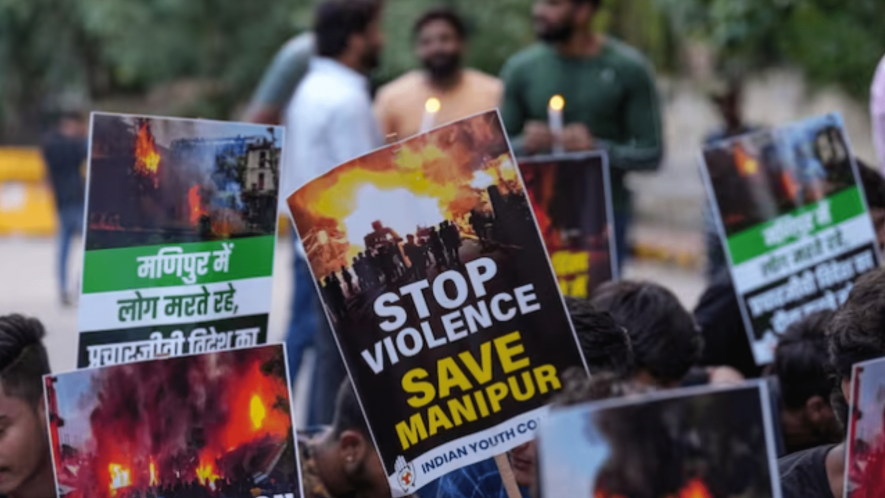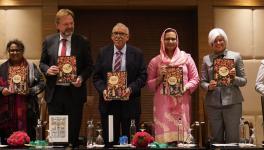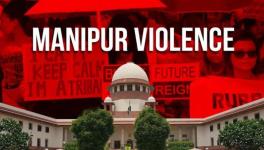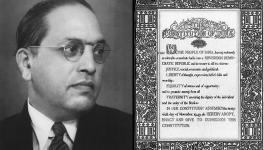Manipur Ethnic Divide: Reconciliation Yet a Far Cry

A candle march to pay tribute to those killed in Manipur violence, at Jantar Mantar in New Delhi. Image Courtesy: PTI
Kolkata: Manipur, a victim of ethnic conflagration for the past 19-and-a-half months – it all started on May 3, 2023 – has become a test case for the reconciliation skills of the N Biren Singh-led state government and the Union Home Ministry; to be more specific, its boss Amit Shah, who is de facto in-charge of law and order in the North-Eastern state and “as a matter of courtesy keeps Biren Singh informed”.
Tribal Kuki-Zo-Hmar groups are in no mood to tolerate any more the majority valley-based Meiteis’ administrative autocracy. They are firm in their demand for a separate administrative arrangement for tribals.
The Meiteis, 53% of Manipur’s population, are all for an integrated Manipur, as it is now. They also want ST (Scheduled Tribe) classification in view of their “disadvantaged position” in regard to resource-related matters, particularly land. It is this demand coupled with a High Court observation that was seen as favouring this demand which is behind the conflagration since May 3, 2023.
The state government and New Delhi (both ruled by the Bharatiya Janata Party) have all along been treating Manipur as a law and order case and have been relying on the unified command of the Army, the state police and the Central paramilitary forces, such as, Assam Rifles, BSF, CRPF and CAPF.
Reluctantly taking note of public demand and suggestions of civil society groups, Shah and Singh have made some attempts to bring the two warring sides to the negotiation table but in view of a firm ‘no’ from the Kuki-Zo-Hmar leadership, they cut a sorry figure.
Instead of renewed efforts with stress on a ‘healing touch’ and involving respected community leaders as also the academia, Shah has been arranging additional security forces and, over a period of time, has manoeuvred to acquire full control over the unified command, although protocol has it that the unified command reports to the Chief Minister and functions under his superintendence.
November and the current month so far have proved administratively more challenging and politically more damaging events for both Singh and Shah. The epicentre of violence for a long time since May 3, 2023 has remained the tribal-dominated Churachandpur district and surrounding areas. But, judging by the events that have unfolded, it may be said that the epicentre has shifted over 200 km away to Jiribam district, which was witness to violence and merciless killings on November 7, 2024, at Zairwan village and on November 11 at Borobekra sub-division.
The victims of the violence were a Hmar woman on November 7 and two Meitei civilians on November 11. On December 14, two migrant construction workers from Bihar were killed in Kakching district and a Meitei youth was killed in an encounter with the police in the adjoining Thoubal district. Both Kakching and Thoubal are Meitei-majority districts.
All these tragedies indicate that peace in Manipur remains a far cry despite deployment of massive forces and combing operations by the Army. Already 260 lives have been lost and over 60,000 have to contend with difficult existence in relief camps.
Much to the discomfiture of Singh and Shah, on November 17 Meghalaya Chief Minister Conrad Sangma’s National People’s party (NPP), the second largest ally with seven MLAs of the BJP-led National Democratic Alliance ministry of Manipur, withdrew support to the Singh ministry, citing its failure to resolve the crisis and restore normalcy. Of course, NPP’s action has not posed a threat to the BJP government as the party itself has 37 MLAs in the 60-member Assembly. But the fact also remains that the Meitei Chief Minister’s relations with seven Kuki MLAs are under severe strain in the given situation.
Perhaps, more damaging for the Chief Minister and Union Home Minister has been the recent suggestion of Mizoram Chief Minister Lalduhoma that the incumbent Chief Minister Singh is a liability to Manipur and that he would prefer Manipur being brought under President’s rule. This evoked a strong reaction from the Manipur government, which also asserted that it does not follow an anti-tribal policy (Page 1, The Telegraph, December 1).
People in the know, who spoke with NewsClick, contended that there was no doubt that Shah was backing Biren Singh to the hilt and the latter was no hindrance to Shah’s controlling the law and order apparatus. However, they also acknowledged that Singh was trying hard to check illegal immigration and drug smuggling from neighbouring Myanmar. Also, he is trying his best to reclaim encroached reserved forests.
The functioning of certain arms of parliamentary democracy has been suffering as the BJP-led government that grabbed power in 2017 in Manipur for the first time, did not bother to take necessary administrative steps.
Elections to Hill Areas Autonomous District Councils (ADCs), urban civic bodies and panchayats have been delayed by two to four years and, as a result, the state government is not able to access an estimated Rs 500 crore it is entitled to under the 15th Finance Commission recommendations, Manipur Congress president Keisham Meghchandra told NewsClick.
“I have raised the issue at the platforms available to me and talked to the Chief Minister. But nothing is happening. Ad hoc arrangements are in vogue; the systems are not functional. In regard to ADCs, is it wrong to contend that the government is being anti-hills, anti-tribals? Meghchandra said.
There are six ADCs: Chandel, Churachandpur, Sadar Hills (Kangkokpi), Manipur North (Senapati), Tamenglong and Ukhrul.
‘A Complex Situation’
Asked about the Manipur situation, Prof Surajit C Mukhopadhyay, dean at the School of Social Studies of Kolkata-based Sister Nivedita University, said: “It’s a complex situation arising from illegalities on a large-scale – unchecked immigration, drug smuggling and free flow of arms from neighbouring Myanmar. As it is, Manipur is backward on every count; no industry to speak about, large-scale unemployment. Administrative lapses have accentuated the state’s problems”.
In the context of the overdue ADC elections, and asked if tribals would take part if the Chief Minister expedited the process, Ajang Khongsai, president of Kuki Inpi, the apex body of Kuki outfits, told NewsClick: “Where is the question? We are asking for separation from Meitei-dominated administration”.
A Legal Take
Dheeraj Murthy, an advocate of the Telangana High Court and Faizan Mustafa, Vice Chancellor of Chanakya National Law University, Patna, observed in an edit in The Hindu of October 24, 2024: “Tripura emerged as an example of peace brokered through the Constitution at the height of the insurgency movement”.
The Tripura Accord was signed in 1988 between the Union government, the state government and the Tripura National Volunteers, a militant group which even sought secession. “The Constitution, as a living and transformative document, has repeatedly evolved its capacity to adapt to demanding circumstances”. .... Ultimately, peace will have to be evolved through the Constitution ... they opined.
The writer is a freelance journalist based in Kolkata.
Get the latest reports & analysis with people's perspective on Protests, movements & deep analytical videos, discussions of the current affairs in your Telegram app. Subscribe to NewsClick's Telegram channel & get Real-Time updates on stories, as they get published on our website.
























